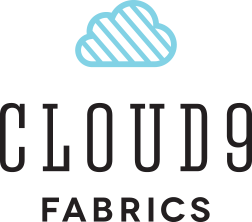WHAT MAKES CLOUD9 FABRICS ECO FRIENDLY?
WHY ORGANIC COTTON?
WHY ARE YOUR FABRICS MADE OFF-SHORE?
WHAT ARE LOW IMPACT DYES?
ARE THERE ANY PERSONAL HEALTH BENEFITS TO USING ORGANIC COTTON?
ARE CLOUD9 FABRICS MORE EXPENSIVE THAN CONVENTIONAL COTTONS?
HOW ARE YOUR FABRICS BLEACHED?
WHAT ARE THE WASHING INSTRUCTIONS FOR CLOUD9 FABRICS?
WILL CLOUD9 FABRICS SHRINK?
What makes Cloud9 Fabrics eco-friendly?
Cotton is the most widely used natural fiber and accounts for up to 50% of the textile market worldwide. Although cotton is also one of the most chemically treated crops and it accounts for roughly 25% of the pesticides and fertilizers used in agriculture, at Cloud9 Fabrics our fabrics use certified organic cotton for farming methods benefiting farmers, processors, Earth, and consumers by using natural, non-toxic means to control crops from seed to harvesting, from milling to finishing.
Why organic cotton?
Organic cotton has a low-impact on the environment and handlers. It is grown and harvested by methods that do not use toxic pesticides, herbicides, fertilizers or defoliants. It relies on natural methods which includes (but is not limited to) crop rotation and cow manure for soil fertility; beneficial predator insects; lengthened growing periods for natural defoliation; and hand-picking, which results in less waste. The statistics from various countries on the health issues of the farmers and handlers of chemically treated crops are startling. The health benefits of organically grown cotton are clear, as are the environmental aspects: reduced toxins and pollutants which infiltrate both the soil and water systems and consequently all living things. It might also be interesting to know also that the cottonseed meal, which is a byproduct of the ginning process, including that of chemically treated cotton, is fed to livestock and can come to us in the form of cottonseed oil in our foods.
Why are your fabrics made off-shore?
After extensive research and sourcing we found that not only are organically grown cotton crops readily available in other regions of the world, the availability of certified organic dyestuff was much more prevalent in the India subcontinent than in any other region in the world, including the US. The India subcontinent provides nearly half the world's organic cotton production and is making great strides in the eco-movement and are doing their part to be able to provide the global market with products that are a healthier and hopeful option than conventionally grown cotton.
What are low-impact dyes?
Conventional dyeing and printing uses a myriad of toxins, including heavy metals, benzene, formaldehydes and organochlorides. The process requires large quantities of water to wash out the residues, which is then dumped into the local waters of the mills. Cloud9 Fabrics are printed with low impact dyes, which are petroleum based. Although they are made from a synthetic material, they are considered to be more eco-friendly in comparison to natural dyes for many reasons. One of the interesting benefits of using low impact dyes is they have a higher absorption rate, which means less dyestuff is actually required to adhere to fibers which also results in a lighter, softer fabric. Likewise, low impact dyes don't require toxic chemical mordants to fix the color to the fabrics as do natural dyes. Low impact dyes are often reclaimed from the liquid waste and the water is recyclable. Another added benefit is that they require less heat which saves energy.
Are there any personal health benefits to using organic cotton?
The information noted above may already convince some of the overall health benefits to our world and the people who process the cotton, but there are aspects of the chemically treated fabric production process which are perhaps less obvious: Most often, chlorine is used to whiten the fibers after weaving; sodium hydroxide is then used to scour or wash the fabric; then it is dyed or printed, typically with the use of formaldehyde fixing agents; finally, there is often the presence of the resin based urea-formaldehyde which is applied in the finishing process and which is heat bonded to cotton fiber for permanent adhesion to reduce shrinkage. This final product in all of its chemical-laden existence, is shipped directly to mills and to consumers.
Are Cloud9 Fabrics more expensive than conventional cottons?
Cloud9 Fabrics is pleased to produce 100% certified organic cotton fabrics that are priced in line with many fine quilting cottons, canvases, flannel and voile. At times, we are even lower.
How are your fabrics bleached?
Our base fabrics are whitened with an organic, non-chlorinated, non-toxic bleaching technique which can result in a more natural cotton color. While synthetic and toxic chemicals can make fabrics amazingly white, the gentler nature of our technique yields a clean naturally white cotton.
What are the washing instructions for Cloud9 Fabrics?
Like most cottons, gentle washing preserves color and fibers longer. We recommend machine wash cold with like colors in a gentle cycle. Non-chlorine bleach when needed. Tumble dry low and remove promptly to avoid wrinkling. Warm iron if needed.
Will Cloud9 Fabrics shrink?
Cloud9 Fabrics will meet a 5% or less shrinkage which is industry standard. When shrinkage is an issue, please be sure to wash and dry the fabrics per our suggested instructions before cutting and sewing.
